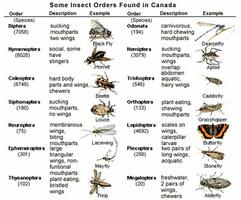
A classification system acts as an efficient storage mechanism for information about each taxon or group. A natural classification also attempts to present the genealogical (historical, phylogenetic) relationships known or hypothesized to exist among them. Necessarily, such a classification is closely linked to and dependent on an understanding of the group's evolution. In the case of insects, different entomologists have different viewpoints on evolutionary history, and are likely to propose quite different classification schemes. Insects are classified primarily on the basis of wing structure, mouthpart structure and type of metamorphosis.
Classification
It is estimated that about 55 000 insect species occur in Canada, categorized in 569 families, belonging to 32 orders. This number includes all Arthropods (segmented, jointed-limbed animals), which have a body divided into head, thorax and abdomen, and 3 pairs of thoracic legs. Insects, defined in a restricted sense, have nonmusculated terminal antennal segments; 6 legs, each having 2 points of articulation with the thorax; and an 11-segmented abdomen.
Exceptions
The class Insecta, as so defined, includes 3 taxa (Protura, Collembola and Diplura) that some entomologists would exclude from a strict definition of an insect. All 3 groups have mouthparts withdrawn into pouches in the head, and are sometimes considered to constitute a natural group, the Entognatha [Gk, "internal jaw"]. While all 3 are primitively wingless, they are very different morphologically. Protura (telsontails) lack antennae and have a 12-segmented abdomen with the female genital opening behind segment 11; 8 species are estimated to occur in Canada. Collembola (springtails and snowfleas) have musculated antennal segments and a 6-segmented abdomen; 520 species are estimated to occur in Canada. Diplura (no common name) have 3-4 spiracles (tracheal openings) on the thorax and a specialized method of leg suspension; 5 species are estimated to occur in Canada.
Two apterygote (wingless) orders have protruding (ectognathous) mouthparts: the Microcoryphia (bristletails, 13 species estimated in Canada), which have mandibles with a single point of attachment to the head capsule; and the Thysanura (firebrats and silverfish, 12 species estimated in Canada), which have mandibles with a double point of attachment to the head capsule.
Winged
Within the subclass Pterygota (winged insects), the infraclass Paleopterygota contains insects unable to fold the wings back and down onto the abdomen. Two very different and rather unrelated orders are represented in the living paleopterygotes, the Ephemeroptera (mayflies, 411 species estimated in Canada) and the Odonata (dragonflies and damselflies, over 190 species estimated in Canada).
In the infraclass Neoptera, all adults are able to fold the wings over the body and flat down onto the abdomen. The group originally had chewing mouthparts, but members of several descendant groups have departed widely from this condition. Three subdivisions (cohorts) are recognized within the Neoptera, each representing an independent evolutionary line.
The Polyneoptera are generally characterized by chewing mouthparts, a distinct anal lobe to the hind wing, abdomen with cerci (appendages), numerous Malpighian tubules (long vessels functioning primarily in excretion), and an incomplete metamorphosis. In incomplete metamorphosis, juveniles in later instars (periods between molts) closely resemble adults and have the same feeding habits, habitat and type of mouthparts.
Eight orders of Polyneoptera can be recognized in the Canadian fauna: Plecoptera (stoneflies, 310 species estimated in Canada); Dictyoptera (cockroaches and mantids, 13-16 species estimated in Canada); Isoptera (termites, 3 species native to Canada); Notoptera (grylloblattids, 5 species estimated in Canada); Dermaptera (earwigs, 5 species estimated in Canada); Grylloptera (long-horned grasshoppers and crickets, 96 species estimated in Canada), which are often grouped in the next order; Orthoptera (short-horned grasshoppers, 140 species estimated in Canada); and Cheleutoptera (stick insects, 2 species estimated in Canada). Orthoptera are the most common worldwide. Notoptera is a very interesting group of secondarily wingless, predaceous insects living in the western mountains, often associated with ice and snow fields. Since they have a rather primitive morphology, they are regarded by some entomologists as living fossils.
The second cohort of the Neoptera, the Paraneoptera, usually have piercing and sucking mouthparts, a hindwing with a very small or no anal lobe, abdomen without cerci, 4 or fewer Malpighian tubules and an incomplete metamorphosis. Four orders can be recognized in the Canadian fauna: Psocoptera (bark and book lice, 103 species estimated in Canada); Phthiraptera (bird and mammal lice, 775 species estimated in Canada); Hemiptera (true bugs, 4226 species estimated in Canada); and Thysanoptera (thrips, 246 species estimated in Canada). Hemiptera are the most abundant worldwide.
The third cohort, the Oligoneoptera, characteristically have a complete metamorphosis, with distinct egg, larval, pupal and adult stages. Such a life cycle permits larvae and adults to diverge in form and habits. The generalized mouthparts are of the chewing type; however, the 10 orders represented in the Canadian fauna have very different ways of feeding.
The commonest order worldwide, the beetles (Coleoptera, 9116 species estimated in Canada), are distinguished by chewing mouthparts and forewings modified as stiff, hard, protective elytra. Next most common are the true flies (Diptera, 14 464 species estimated in Canada), distinguished by having only one pair of wings, the forewings. The most familiar group is probably the Hymenoptera (bees, wasps and ants, 16 665 species estimated in Canada), most of which have constricted waists allowing stinging movements.
The remaining orders of Oligoneoptera are, in order of Canadian representatives: Lepidoptera (butterflies and moths, with 6734 species estimated in Canada); Trichoptera (caddisflies, 546 known); Siphonaptera (fleas, 190 estimated); Neuroptera (lacewings, etc, 75 known); Mecoptera (scorpionflies, 32); Megaloptera (dobsonflies and alderflies, 16 known); and Raphidioptera (snakeflies, 6).

 Share on Facebook
Share on Facebook Share on X
Share on X Share by Email
Share by Email Share on Google Classroom
Share on Google Classroom

